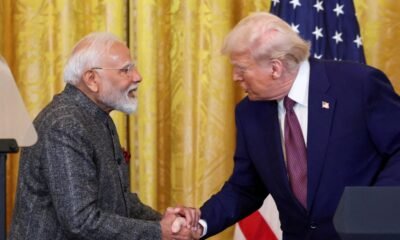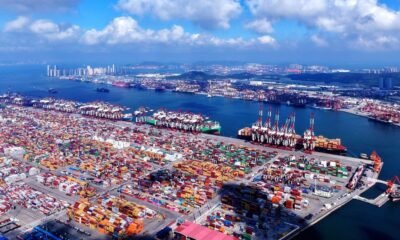Economy
Trump gets his way on tariffs, but can global trade system endure?
U.S. President Donald Trump has largely succeeded in convincing nations to accept higher tariffs on exports to the U.S.; yet for now, some experts see little threat to the post-war trend of lower duties, although potential changes in the global trade system are visible.
Since World War II, most politicians and economists have viewed free trade as a pillar of globalization, enshrined in the 1947 signing of the GATT accord.
It was the precursor to the World Trade Organization (WTO), which now has 166 members and covers 98% of global commerce.
“What we’ve learned in the postwar is that lower tariffs are better for the prosperity of your own country,” said Richard Baldwin, a professor at the IMD Business School in Switzerland.
“And it’s also good if other countries lower their tariffs, so we have a vibrant international economy,” Baldwin, who was a member of former U.S. President George Bush’s Council of Economic Advisors, told Agence France-Presse (AFP).
Trump, however, has embarked on a punishing trade war, claiming that deficits with other nations show they are “ripping off” the U.S.
He has recently landed accords with Japan, the Philippines, Indonesia and, most importantly, the European Union.
For dozens of other nations, U.S. “reciprocal” tariffs are set to increase from 10% to various steeper levels starting Aug. 1, including major economies such as South Korea, India and Brazil.
“To me, the most beautiful word in the dictionary is ‘tariff,'” Trump repeatedly said during the 2024 election campaign that returned him to office.
‘Pyrrhic victory’
Despite the headline figures, many economists expect the overall impact on the global trade system to be limited.
U.S. importers may well decide to procure more from American producers as the tariffs are applied, or pass along the higher costs to consumers.
“That won’t have a systemic impact” outside the U.S., Pascal Lamy, a former WTO chief, told AFP, calling the tariffs a “Pyrrhic victory” for Trump.
He noted that Trump is targeting only the U.S. deficits for goods, not services, “the part of global trade that is increasing the fastest.”
“You need to change your outlook when it comes to international trade,” Lamy said, adding that “Donald Trump has a medieval view” of the issue.
And instead of making a country more prosperous, the accepted economic wisdom is that by making goods more expensive, tariffs weigh on economic growth for everyone involved.
“Putting up your own tariffs is not a way to make yourself richer – that’s something that people have given up on many years ago,” Baldwin said.
“Trump has not screwed up the entire world trading system yet because the rest of the world hasn’t changed their opinion as to whether trade is good or bad,” he said.
“And generally speaking, it’s good.”
Indeed, others, including China, which joined the WTO in the early 2000s, have repeatedly called for respecting trade rules and engaging in dialogue.
Yet, from Aug. 1, although smaller than initially announced, South Korean exports to the U.S. would face 15% levy and those from Brazil a steep 50%, the highest announced rate so far.
And, although touted as the “deal” by the Trump administration, Seoul, similarly to the EU, has pledged to invest billions in the U.S.
Trade alliances
Global trade has risen sharply in recent decades, totalling nearly $24 trillion in 2023, according to WTO figures.
U.S. imports represent just 13% of overall imports – meaning the vast majority of international commerce will not be directly affected by Trump’s levies.
“It’s significant, but it’s only a small part of imports worldwide and the rest of the world still wants the system of engagement and interdependence to work,” said Elvire Fabry, a specialist in geopolitical economics at the Jacques Delors Institute.
Several countries have moved in recent years to forge new trade deals, a trend Trump’s tariffs blitz could accelerate.
In March, Japan, South Korea and China pledged to speed up negotiations on an accord, while Brazil’s President Luiz Inacio Lula da Silva has called for a deal between the Mercosur Latin American bloc and Japan.
The EU has also signed a free-trade deal with Mercosur, although its ratification has been held up, particularly by France, over concerns about unfair agricultural competition.
The EU has also relaunched efforts to secure a deal with Malaysia and countries in Central Asia.
Like this, it appears that many nations are attempting to quickly adjust to the new norm and form trade alliances to mitigate the vulnerability posed by the duties.
Tariff impact
In April, the WTO stated that global merchandise trade would decline by 0.2% this year before experiencing a “modest” recovery to growth of 2.5% in 2026.
However, those forecasts only took into account the tariffs Trump had announced up to that point – not the more severe levels he has threatened to implement starting Aug. 1 for countries that have not signed deals with Washington.
Still, as a sign that the impact of tariffs might not be as much as initially thought, the International Monetary Fund (IMF) earlier this week also revised slightly upward its growth forecasts for this year and next and the U.S. economy returned to growth in the second quarter.
On the other hand, industry-dependent economies, steel, aluminum and auto exporters, as well as those having individually large trade volumes with the U.S., stand at risk due to the quickly changing trade environment.
The tariff increases by the U.S. could result in medium-term export losses of up to 31 billion euros ($35.8 billion) for German industry in its business with the U.S., according to calculations by the consultancy firm Deloitte, released on Wednesday.
German exports to the U.S. could, therefore, decrease by a fifth, Deloitte said.
Economy
Trump ousts jobs data chief after weak employment report
President Donald Trump on Friday fired the chief of the agency responsible for monthly jobs reports after data showed weaker-than-expected hiring in July and major downward revisions for May and June.
Trump, in a post on his social media platform, alleged that the figures were manipulated for political reasons and said that Erika McEntarfer, the director of the Bureau of Labor Statistics, who was appointed by former President Joe Biden, should be fired. He provided no evidence for the charge.
“I have directed my Team to fire this Biden Political Appointee, IMMEDIATELY,” Trump said on Truth Social. “She will be replaced with someone much more competent and qualified.”
After his post, Labor Secretary Lori Chavez-DeRemer said on X that McEntarfer was no longer leading the bureau and that William Wiatrowski, the deputy commissioner, would serve as the acting director.
“I support the President’s decision to replace Biden’s Commissioner and ensure the American People can trust the important and influential data coming from BLS,” Chavez-DeRemer said.
Friday’s jobs report showed that just 73,000 jobs were added last month and that 258,000 fewer jobs were created in May and June than previously estimated.
McEntarfer was nominated by Biden in 2023 and became the Commissioner of the Bureau of Labor Statistics in January 2024. Commissioners typically serve four-year terms but since they are political appointees can be fired. The commissioner is the only political appointee of the agency, which has hundreds of career civil servants.
Trump focused much of his ire on the revisions the agency made to previous hiring data. Job gains in May were revised down to just 19,000 from 125,000, and for June they were cut to 14,000 from 147,000. In July, only 73,000 positions were added. The unemployment rate ticked up to a still-low 4.2% from 4.1%.
“No one can be that wrong? We need accurate Jobs Numbers,” Trump wrote. “She will be replaced with someone much more competent and qualified. Important numbers like this must be fair and accurate, they can’t be manipulated for political purposes.”
The monthly employment report is one of the most closely-watched pieces of government economic data and can cause sharp swings in financial markets. The disappointing figure sent U.S. market indexes about 1.5% lower Friday.
While the jobs numbers are often the subject of political spin, economists and Wall Street investors – with millions of dollars at stake – have always accepted U.S. government economic data as free from political manipulation.
Economy
Türkiye says still holds favorable status despite higher US tariffs
Türkiye said on Friday it was still among a few countries with relatively favorable trade terms after the U.S. issued a new set of tariffs that will apply to dozens of countries and that include higher duties on Turkish imports.
Late Thursday, President Donald Trump signed an executive order imposing tariffs ranging from 10% to 41% on goods from dozens of trade partners as of Aug. 7. Rates were set at 25% for India’s U.S.-bound exports, 20% for Taiwan’s, 19% for Thailand’s and 15% for South Korea’s.
The White House said the tariff for products from Canada would rise to 35% from 25%, effective Friday. But Trump gave Mexico a 90-day reprieve from higher tariffs to negotiate a broader trade deal.
Under the new measures, tariffs on Turkish products were increased to 15%, compared to 10% that was announced by Trump as a baseline duty in April.
Despite that, Türkiye continues to “positively decouple” itself, the Trade Ministry said in a statement on Friday, highlighting that the country remains among the countries subject to the lowest customs duties.
The ministry said Türkiye’s position shows that it is regarded as “a balanced and constructive trade partner” by the U.S.
It suggested that Turkish exporters “retain their competitive edge” in global markets and that Türkiye’s “strong” position in international trade “remains intact.”
Compared to many Asian and Latin American countries, the ministry said, Türkiye’s lower tariff category represents a significant advantage.
Meanwhile, talks are ongoing between the two countries at diplomatic and technical levels, particularly regarding tariffs on strategic sectors such as steel, automotive and copper, the statement said.
Negotiations also aim to secure more favorable terms for Türkiye’s textile and apparel sectors, the ministry added.
“The priority is to ensure that trade with the U.S. proceeds in a predictable, fair, and sustainable framework,” the statement said, adding that Türkiye’s inclusion among countries with positive progress in negotiations demonstrates strengthening mutual dialogue and cooperation in bilateral trade relations.
Economy
US hiring drops as Trump pushes trade agenda
U.S. job growth is cooling significantly as President Donald Trump’s unpredictable trade policies unsettle businesses and cloud the outlook for the world’s largest economy.
The Labor Department reported Friday that U.S. employers added just 73,000 jobs last month, well short of the 115,000 forecasters had expected.
Worse, revisions shaved a stunning 258,000 jobs off May and June payrolls. And the unemployment rate ticked up to 4.2% as Americans dropped out of the labor force and the ranks of the unemployed rose by 221,000.
“A notable deterioration in U.S. labor market conditions appears to be underway,” said Scott Anderson, chief U.S. economist at BMO Capital Markets. ”We have been forecasting this since the tariff and trade war erupted this spring and more restrictive immigration restrictions were put in place. Overall, this report highlights the risk of a harder landing for the labor market.”
Economists have been warning that the rift with every U.S. trading partner will begin to appear this summer and the Friday jobs report appeared to sound the bell.
“We’re finally in the eye of the hurricane,” said Daniel Zhao, chief economist at Glassdoor. “After months of warning signs, the July jobs report confirms that the slowdown isn’t just approaching-it’s here.”
U.S. markets recoiled and the jobs report and the Dow tumbled more than 600 points at the opening bell Friday.
The revelations in the new data raise questions about the health of the job market and the economy as President Donald Trump pushes forward with an unorthodox overhaul of American trade policy.
Trump has discarded decades of U.S. policy that had favored fewer barriers and ever-freer trade. Instead, Trump is imposing hefty import taxes – tariffs – on products from almost every country on earth. Trump believes the levies will bring manufacturing back to America and raise money to pay for the massive tax cuts he signed into law July 4.
Mainstream economists say the cost of the tariffs will be passed along to Americans, both businesses and households. That has already begun to happen.
Walmart, Procter & Gamble, Ford, Best Buy, Adidas, Nike, Mattel, Shein, Temu, Stanley Black & Decker, have all announced, or said that they would hike prices, due to U.S. tariffs.
Trump has also sowed uncertainty in the erratic way he’s rolled the tariffs out – announcing, then suspending them, then coming up with new ones. Overnight, Trump signed an executive order that set new tariffs on a wide swath of U.S. trading partners to that go into effect on Aug. 7., and that arrived after a flurry of unexpected tariff-related actions this week.
“There was a clear, significant, immediate, tariff effect on the labor market and employment growth essentially stalled, as we were dealing with so much uncertainty about the outlook for the economy and for tariffs,” said Blerina Uruci, chief U.S. economist for the brokerage T. Rowe Price.
Still, Uruci said the data suggests we could be past the worst, as hiring actually did pick up a bit in July from May and June’s revised and depressed levels.
“I’m not overly pessimistic on the U.S. economy based on this morning’s data,” she said, though she does think that hiring will remain muted in the coming months as the number of available workers remains limited due to reduced immigration and an aging population.
Trump has sold the tariffs hikes as a way to boost American manufacturing, but factories cut 11,000 jobs last month after shedding 15,000 in June and 11,000 in May. The federal government, where employment has been targeted by the Trump administration, lost 12,000 jobs. Jobs in administration and support fell by nearly 20,000.
Healthcare companies added 55,400 jobs last month – accounting for 76% of the jobs added in July and offering another sign that recent job gains have been narrowly concentrated.
The department originally reported that state and local governments had added 64,000 jobs in education in June. After the revisions released Friday, that number fell to below 10,000.
After the big revisions for May and June, Labor Department data show that the U.S. economy has generated an average of just 85,000 jobs a month this year, barely half last year’s average of 168,000 and well below an average 400,000 from 2021-2023 as the economy rebounded from COVID-19 lockups.
The weak jobs data makes it more likely that Trump will get one thing that he most fervently desires: A cut in short-term interest rates by the Federal Reserve, which often — though not always — can lead to lower rates for mortgages, car loans, and credit cards.
Fed Chair Jerome Powell and other Fed officials have repeatedly pointed to a healthy job market as a reason that they could take time to evaluate how Trump’s tariffs were affecting inflation and the broader economy. Now that assessment has been undercut and will put more pressure on the Fed to reduce borrowing costs.
Wall Street investors sharply raised their expectations for a rate cut at the Fed’s next meeting in September after the report was released.
On Wednesday, the Fed left its key rate unchanged for the fifth straight meeting and Powell signaled little urgency to reduce rates anytime soon. He said the “labor market is solid” with “historically low unemployment.” But he also acknowledged there is a “downside risk” to employment stemming from the slow pace of hiring that was evident even before Friday’s weaker numbers.
The current situation is a sharp reversal from the hiring boom of just three years ago when desperate employers were handing out signing bonuses and introducing perks such as Fridays off, fertility benefits and even pet insurance to recruit and keep workers.
The rate of people quitting their jobs – a sign they’re confident they can land something better – has fallen from the record heights of 2021 and 2022 and is now below where it stood before the pandemic.
Drees Homes, a homebuilder based outside Cincinnati in Fort Mitchell, Kentucky, has hired about 50 people over the past year, bringing its workforce to around 950. Pamela Rader, Drees’ vice president for human resources, it’s “gotten a little bit easier’’ to find workers.
A couple of years ago, Rader said jobseekers were focused on getting more pay. Now, she said, they emphasize a better work-life balance, stable employment and prospects for advancement.
Economy
Trump calls on Fed board to assume control if Powell won’t cut rates
U.S. President Donald Trump said on Friday the Federal Reserve (Fed) board should “assume control” if Fed Chair Jerome Powell continues to refuse to lower interest rates.
Posting on his Truth Social platform, Trump called Powell “stubborn.” The Fed chair has been subjected to vicious verbal attacks by the Republican president over several months.
“Jerome ‘Too Late’ Powell, a stubborn MORON, must substantially lower interest rates, NOW,” Trump said. “IF HE CONTINUES TO REFUSE, THE BOARD SHOULD ASSUME CONTROL, AND DO WHAT EVERYONE KNOWS HAS TO BE DONE!” he added.
The U.S. central bank held interest rates steady on Wednesday and Powell’s comments after the decision undercut confidence that borrowing costs would begin to fall in September, stoking the ire of Trump, who has demanded immediate and steep rate relief.
The Fed has the responsibility of stabilizing prices and maximizing employment. Powell has held its benchmark rate for overnight loans constant this year, saying that Fed officials needed to see what impact Trump’s massive tariffs had on inflation.
The latest policy decision was made by a 9-2 vote, which passes for a split outcome at the consensus-driven central bank, with two Fed governors dissenting for the first time in more than 30 years.
The seven members of the Fed Board of Governors are nominated by the president and confirmed by the U.S. Senate.
Trump has repeatedly demanded the Fed cut interest rates, citing moves by the European central banks and warned that delays could stall the U.S. economy.
He sees the rate cuts as leading to stronger growth and lower debt servicing costs for the federal government and homebuyers. The president argues there is virtually no inflation, even though the Fed’s preferred measure is running at an annual rate of 2.6%, slightly higher than the Fed’s 2% target.
Trump has called for slashing the Fed’s benchmark rate by 3 percentage points, bringing it down dramatically from its current average of 4.33%. The risk is that a rate cut that large could cause more money to come into the economy than can be absorbed, possibly causing inflation to accelerate.
Trump has previously denied reports that he is looking to fire Powell before the Fed chair’s term ends next year, calling such a move “highly unlikely,” but left the door open to taking action over what he called “possible” fraud.
The Supreme Court suggested in a May ruling that Trump could not remove Powell for policy disagreements. This led the White House to investigate whether the Fed chair could be fired for cause because of the cost overruns in its $2.5 billion renovation projects.
Powell’s term as chair ends in May 2026, at which point Trump can put his Senate-confirmed pick in the seat.
Economy
Turkish manufacturing sector lost further pace in July: PMI
Türkiye’s manufacturing sector continued to lose momentum in July, a survey showed Friday, as weak demand caused significant slowdowns in both new orders and output.
The Türkiye Manufacturing Purchasing Managers’ Index (PMI) fell to 45.9 in July from 46.7 in June, the Istanbul Chamber of Industry (ISO) said.
That marked the third consecutive monthly decline and the most pronounced moderation since October 2024.
PMI readings above 50.0 indicate growth in activity, while those below point to a contraction. Business conditions have now eased for 16 consecutive months, underscoring persistent challenges in the sector.
A key theme of the latest survey was subdued customer demand and, in turn, new orders easing the most since March, the survey showed, while international demand also remained weak.
Consequently, manufacturers scaled back production while employment and purchasing activity were reduced, and efforts were made to limit inventory holdings, the panel showed.
Stocks of purchases eased to the largest degree since October 2024, while stocks of finished goods were markedly depleted following a slight rise in June.
Currency weakness continued to drive sharp increases in input costs while selling prices rose at a slightly faster pace than in June.
“There was little in the way of positive news from the latest Turkey manufacturing PMI as the challenges for firms in securing new orders percolated through the sector,” said Andrew Harker, Economics Director at S&P Global Market Intelligence.
“Manufacturers will be hoping to see some pick-up in demand conditions as the second half of the year progresses.”
Economy
Trump issues new set of steep tariffs, punishes Canada
President Donald Trump has signed an executive order that will introduce new tariffs on nearly 70 countries, including a hike on Canadian imports, as the global economy and alliances face another test from the U.S.’ trade agenda.
However, in a minor reprieve that opens the door to further negotiations, the White House said the measures will take effect in a week for most countries, not Friday as previously expected.
Trump’s order issued Thursday night came after a flurry of tariff-related activity in recent days as the White House announced agreements with various nations and blocs before a deadline set by the president for Aug. 1.
The import levies on 68 countries and the European Union ranged from a 50% duty for Brazil, 39% for Switzerland, 25% for India, 20% for Taiwan and 15% for Türkiye, according to a presidential executive order.
They also included an increase on Canadian imports to 35%, citing a lack of cooperation on illicit drugs. Trump had warned of trade consequences for Canada after Prime Minister Mark Carney announced plans to recognize a Palestinian state at the U.N. General Assembly in September.
Unlike the new levies hitting dozens of other economies, there is no delay and these begin Friday, according to a White House fact sheet.
Trump also said he would extend trade negotiations with Mexico for 90 days.
The new tariffs drew expressions of relief Friday from some countries that negotiated a deal or managed to whittle them down from rates announced in April. Others expressed disappointment or frustration over running out of time after hitting Trump’s deadline for striking deals with America’s trading partners.
The new rates are due to take effect on Aug. 7, but uncertainty over what Trump might do next remains.
Countries not listed in the Thursday night order would be charged a baseline 10% tariff.
The Trump administration also teased that more trade deals were in the pipeline as it seeks to close trade deficits and boost domestic factories.
The Republican president has tapped emergency powers, pressured foreign leaders, and pressed ahead with trade policies that sparked a market sell-off when they were first announced in April.
U.S. federal appeals court judges on Thursday questioned Trump’s use of the emergency powers to justify his tariffs.
Trump invoked the 1977 International Emergency Economic Powers Act to declare an “emergency” over the growing U.S. trade deficit and impose his “reciprocal” tariffs and a separate fentanyl emergency, allowing him to avoid congressional approval.
Trump was ebullient as much of the world awaited what he would do.
“Tariffs are making America GREAT & RICH Again,” he said Thursday morning on Truth Social.
Asian shares were headed for the worst week since April on Friday after the tariffs were announced.
European stocks hit a three-week low on Friday as investors focused on the impact of the new tariffs. The pan-European STOXX 600 index fell around 1% in early trading, down for the third straight session and on track to end the week in the red.
Switzerland, Taiwan, South Africa
EU exports to the United States are set to face tariffs of 15% on most products after both sides struck a deal to avoid a higher 30% level.
European Commission President Ursula von der Leyen said some agricultural products would be exempt under the agreement struck Sunday, though she did not specify which.
But France’s President Emmanuel Macron pledged to be “firm” in follow-up talks. “It’s not the end of it,” Macron told ministers during a cabinet meeting.
The tariff on Swiss goods marked an increase from the 31% rate U.S. had been threatening to implement. Switzerland said it would push for a “negotiated solution” with the U.S. to try to avoid harm to its key pharmaceutical industry.
Taiwan leader Lai Ching-te said the new 20% tariff rate for the island was “temporary” and that he expected to reach a lower figure.
South Africa’s Trade Minister Parks Tau said he was seeking “real, practical interventions” to defend jobs and the economy against the 30% U.S. tariff it faces.
Trump’s order said some trading partners, “despite having engaged in negotiations, have offered terms that, in my judgment, do not sufficiently address imbalances in our trading relationship or have failed to align sufficiently with the United States on economic and national-security matters.”
Other details are still to come, including on the “rules of origin” that will determine what products might face even higher tariffs.
Canada, Mexico, India
Trump issued a separate order that raises the rate on Canadian goods subject to fentanyl-related tariffs from 25% previously, saying Canada had “failed to cooperate” in curbing illicit narcotics flows into the U.S.
That contrasted sharply with Trump’s decision to grant Mexico a 90-day reprieve from higher tariffs of 30% on many goods to allow time to negotiate a broader trade pact.
Canada’s Carney said he was disappointed by Trump’s decision, and vowed to take action to protect Canadian jobs and diversify exports.
“While we will continue to negotiate with the United States on our trading relationship, the Canadian government is laser focused on what we can control: building Canada strong,” he said in a post on social media platform X.
Carney has already indicated that his country can no longer rely on the U.S. as an ally, and Trump declined to talk to him on Thursday.
The extension for Mexico avoids a 30% tariff on most Mexican non-automotive and non-metal goods compliant with the U.S.-Mexico-Canada Agreement (USMCA) on trade and came after a Thursday call between Trump and Mexican President Claudia Sheinbaum.
“We avoided the tariff increase announced for tomorrow,” Sheinbaum wrote on X, saying the Trump call was “very good.”
About 85% of U.S. imports from Mexico comply with the rules of origin outlined in the USMCA, shielding them from 25% tariffs related to fentanyl, according to Mexico’s Economy Ministry.
Trump said the U.S. would continue to levy a 50% tariff on Mexican steel, aluminum and copper and a 25% tariff on Mexican autos and on non-USMCA-compliant goods subject to tariffs related to the U.S. fentanyl crisis.
“Additionally, Mexico has agreed to immediately terminate its Non Tariff Trade Barriers, of which there were many,” Trump said in a Truth Social post, without providing details.
Indian goods seemed headed for a 25% tariff after talks bogged down over access to India’s agriculture sector, drawing a higher-rate threat from Trump that included an unspecified penalty for India’s purchases of Russian oil.
“I don’t care what India does with Russia. They can take their dead economies down together, for all I care,” Trump said on social media on Wednesday.
New Delhi vowed to protect the country’s farm sector, and the threat of higher rates from Trump triggered outrage from the opposition party and a slump in the rupee.
With the new rate, India may no longer benefit as much from efforts to pivot manufacturing out of China.
Brazil, China, South Korea
Trump hit Brazil’s exports on Wednesday with a 50% tariff as he escalated his fight with the country over its prosecution of former President Jair Bolsonaro, but softened the blow by excluding sectors such as aircraft, energy and orange juice from heavier levies.
Meanwhile, China is facing an Aug. 12 deadline to reach a durable tariff agreement with Trump’s administration after Beijing and Washington reached preliminary deals in May and June to end tit-for-tat tariffs and a cut-off of rare earth minerals.
A U.S. official told reporters that they are making progress toward a deal.
China, which faces a 30% tariff and is charging a 10% retaliatory rate on the U.S., on Friday warned that U.S. protectionism “harms the interests of all parties.”
“The Chinese side’s opposition to tariffs has been consistent and clear,” Foreign Ministry spokesperson Guo Jiakun said, adding: “There is no winner in a tariff war or trade war.”
Just days before the tariff deadline, U.S. and South Korea reached a deal to avert a 25% duty on South Korean goods, bringing the level down to 15% instead.
In making the announcement Wednesday, Trump said the country also committed to $350 billion in investments and to purchase $100 billion worth of liquefied natural gas (LNG) or other energy resources.
The 15% rate matches levels determined from U.S. accords with Japan and the European Union. Tariffs on automobiles will also stay at 15%, Seoul said.
-

 Politics3 days ago
Politics3 days agoOne state: YPG terrorist group appears bowing to Damascus
-

 Daily Agenda3 days ago
Daily Agenda3 days agoDENSITY FROM DMM to Founded Claims about Bogota Declaration
-

 Daily Agenda1 day ago
Daily Agenda1 day agoTayfun Kahraman’s decision from the AYM: will be re -trial
-

 Daily Agenda1 day ago
Daily Agenda1 day agoIstanbul Provincial Gendarmerie Commander Yusuf Kenan Topcu was promoted to Lieutenant General
-

 Economy1 day ago
Economy1 day agoTürkiye’s tourism revenues jump 7.6% to nearly $26B in H1
-

 Politics2 days ago
Politics2 days agoTurkish main opposition leader signals quitting politics if defeated
-

 Economy2 days ago
Economy2 days agoTrump announces 25% tariff on India, penalties over Russian energy
-

 Economy2 days ago
Economy2 days agoChina vows to support tariff-hit companies as US talks left in limbo




